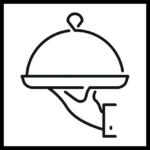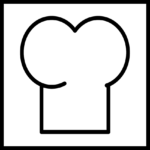Personal hygiene is one of the most critical aspects of food safety. When working in foodservice, it is essential for all staff members to maintain strict personal hygiene standards to prevent contamination and foodborne illness. This chapter explains the key practices food handlers must follow to ensure they do not compromise the safety of the food they prepare or serve.
Why Personal Hygiene is Important
Food handlers can unintentionally introduce harmful pathogens to food in many ways. Contamination can occur during every stage of food preparation, from receiving ingredients to serving meals. Some of the most common ways food handlers contaminate food include:
- Working While Sick: Illnesses such as the flu, gastroenteritis, and foodborne illnesses like Hepatitis A or Norovirus can easily spread from sick food handlers to the food they prepare.
- Not Washing Hands: Hands can pick up bacteria and viruses from many sources, including restrooms, dirty equipment, and handling raw food.
- Improper Glove Use: Not changing gloves between tasks or using them as a substitute for handwashing can lead to contamination.
- Touching Contaminated Surfaces: Touching unclean surfaces, such as counters or equipment, and then handling food can spread pathogens.
- Handling Food with Unclean Body or Clothes: Poor personal cleanliness, including dirty uniforms or unkempt grooming, can introduce contaminants to food.
Even food handlers who seem healthy may carry pathogens without showing symptoms, making it crucial to follow hygiene procedures at all times.
Personal Behaviors to Avoid in the Workplace
Certain habits can introduce contaminants into food and should always be avoided while working in a food service environment. These include:
- Scratching your skin, face, or scalp.
- Running fingers through hair
- Wiping or touching the face, nose, or mouth
- Rubbing or touching an open wound or pimple
- Wearing a dirty uniform or apron
- Coughing or sneezing into hands
- Spitting or using tobacco in food preparation areas
Personal Hygiene Program
A solid personal hygiene program is essential to maintaining food safety in any foodservice operation. This program should address several key areas:
- Hand Hygiene: Proper handwashing techniques, when and how to wash hands, and the correct use of gloves.
- Personal Cleanliness: Ensuring that staff arrive to work clean and well-groomed.
- Work Attire: Establishing guidelines for clean uniforms, proper use of aprons, and restrictions on jewelry.
- Illness Reporting: Encouraging staff to report illnesses and preventing sick employees from working with or around food.
Managers play a critical role in implementing and maintaining these hygiene programs. They must create clear policies, train employees regularly, and lead by example.
Eating, Drinking, Smoking, and Chewing Gum
Food handlers must avoid eating, drinking, smoking, vaping, and chewing gum or tobacco in food preparation and service areas. Saliva can contain harmful pathogens that may be transferred to food. These activities should only take place in designated staff areas.
The Importance of Handwashing
Handwashing is one of the most effective ways to prevent the spread of foodborne illnesses. Hands are constantly in contact with various surfaces that may carry pathogens, and without proper handwashing, these germs can be transferred to food.
When to Wash Hands
Food handlers must wash their hands before starting work and after the following activities:
- Using the restroom
- Handling raw meat, poultry, or seafood
- Touching the face, hair, or body
- Sneezing, coughing, or using a tissue
- Eating, drinking, smoking, or chewing gum
- Handling chemicals
- Taking out the trash or cleaning tables
- Handling money
- Touching dirty equipment or surfaces
How to Wash Hands Properly
The WHO established a standard 11-step protocol for handwashing. It is important, especially after the pandemic, everyone follows these protocols. This process should last between 40 and 60 seconds:
1. Wet your hands with water.

2. Place enough soap in the palm of your hand to cover the surface of your hands.

3. Rub the palms of your hands together.

4. Rub the palm of your right hand against the back of your left hand, interlacing your fingers and vice versa.

5. Rub the palms of your hands together, with your fingers interlaced.

6. Rub the back of the fingers of one hand with the palm of the opposite hand, holding your fingers.

7. Rub your left thumb in a rotating motion, trapping it with the palm of your right hand and vice versa.

8. Rub the tips of the fingers of your right hand against your left hand, making a rotating motion and vice versa.

9. Wash your wrists.

10. Rinse your hands with water.

11. Dry your hands with a disposable towel.

Your hands are clean, use the towel to turn off the faucet so they stay clean.

Hand Antiseptics
Hand sanitizers, or antiseptics, can be used in addition to handwashing but never as a substitute. They must meet FDA standards and should only be used after hands are properly washed. Always allow hand antiseptics to dry before touching food or equipment.
Hand Care and Fingernails
To avoid contaminating food, food handlers must take proper care of their hands:
- Fingernails: Keep nails short, clean, and well-trimmed. Long or artificial nails and nail polish should not be worn unless gloves are used, as they can harbor bacteria or break off into food.
- Wounds: Cover any cuts, wounds, or boils with a clean, waterproof bandage. If the wound is on the hand, wear gloves over the bandage to ensure it stays covered.
Proper Use of Gloves
Gloves are a vital barrier that helps prevent bare-hand contact with food, especially when handling ready-to-eat foods. However, gloves must be used correctly to be effective.
When to Use Gloves
Gloves should be worn when:
- Handling ready-to-eat food
- Working with ingredients that will not be cooked to a safe internal temperature
How to Use Gloves Properly
- Wash hands before putting on gloves.
- Select the correct glove size.
- Hold gloves by the edge when putting them on to avoid touching the glove surface.
- Inspect gloves for tears or damage before using.
- Change gloves between tasks, after handling raw meat, and whenever they become dirty or torn.
Avoiding Bare-Hand Contact with Ready-to-Eat Food
Whenever possible, food handlers should avoid touching ready-to-eat foods with their bare hands. This is particularly important in establishments that serve high-risk populations, such as the elderly, young children, or people with compromised immune systems. If bare-hand contact is allowed, specific hygiene policies and handwashing training must be enforced.
Personal Cleanliness and Work Attire
Maintaining personal cleanliness is essential for food safety. Food handlers should arrive at work freshly bathed, with clean hair and clothes. Personal grooming standards should be strictly followed to reduce the risk of contaminating food.
Work Attire Guidelines
- Hair Restraints: All food handlers should wear a clean hat or hair restraint to prevent hair from falling into food. Those with facial hair should also wear beard restraints.
- Clean Uniforms: Wear clean clothing and change into work attire at the establishment, if possible. Dirty uniforms should be kept away from food prep areas.
- Jewelry: Rings (except plain bands), bracelets, watches, and other jewelry should not be worn while handling food, as these items can harbor bacteria and become physical contaminants.
Managing Cuts and Wounds
Cover any cuts or wounds on the hands with waterproof bandages before donning gloves. This practice is crucial in preventing pathogens from infecting food. Employees must take immediate action upon sustaining any cut or abrasion:
- Cover all cuts, wounds, or abrasions with a waterproof, durable bandage or dressing. This barrier prevents bacteria from the wound from contaminating food.
- After applying a bandage, wear gloves as an additional layer of protection. Ensure gloves are changed regularly and anytime a new wound is attended to.
- Fresh tattoos that have not yet healed are essentially open wounds and require careful management. cover them with a waterproof barrier, especially if they are on arms or hands, to prevent any leakage of fluids that could contaminate food or work surfaces.
- Regularly inspect wound coverings to ensure they remain intact during work hours. If a covering becomes compromised, it should be replaced immediately.
Proper Storage of Personal Items
Proper storage of personal items by foodservice employees is crucial to maintain a hygienic work environment and prevent contamination of food and food contact surfaces. Mobile phones, Bags and Purses, Outerwear such as jackets, and Jewelry should be stored in a safe place away from food.
Reporting Illnesses
Illnesses can easily spread through a foodservice establishment if not properly managed. Employees must report any symptoms of illness to their manager before working with food. This includes common symptoms like vomiting, diarrhea, or jaundice. Food handlers diagnosed with a serious foodborne illness, such as Norovirus, Salmonella, or Hepatitis A, must stay home until cleared by a medical professional.
Best Practices for Cough and Sneeze Etiquette
- Use a tissue to cover your mouth and nose when coughing or sneezing. If a tissue is not available, cough or sneeze into your elbow or upper sleeve, not your hands. This method reduces the risk of contaminating hands that come into contact with food and surfaces.
- Avoid touching your face, especially your mouth, nose, and eyes, with unwashed hands to prevent the transfer of pathogens from surfaces to your respiratory system.
- Wear a mask or face covering if experiencing coughing or sneezing, especially during outbreaks of respiratory illnesses. Masks can help contain respiratory droplets and prevent the spread of illness.
Handling Sick Employees
If you are sick, you should not work with food. Foodservice workers and managers are responsible for ensuring that sick employees do not work with food. Staff who show signs of illness should be restricted from food preparation areas or excluded from work altogether, depending on the severity of the illness. Common conditions that require exclusion include:
- Vomiting or diarrhea
- Jaundice (yellowing of the skin or eyes)
- Diagnosed foodborne illnesses
Employees can return to work once they have been symptom-free for at least 24 hours or have received medical clearance.
Conclusion
Maintaining personal hygiene is critical for food safety in any foodservice operation. By following proper handwashing techniques, wearing appropriate attire, avoiding unsafe personal behaviors, and reporting illnesses, food handlers can play a key role in preventing contamination and ensuring that the food they prepare is safe for consumption.













 Business 1300
Business 1300

 Business 4300 – Sous Chef
Business 4300 – Sous Chef
 Business 6300 – Executive Chef
Business 6300 – Executive Chef
